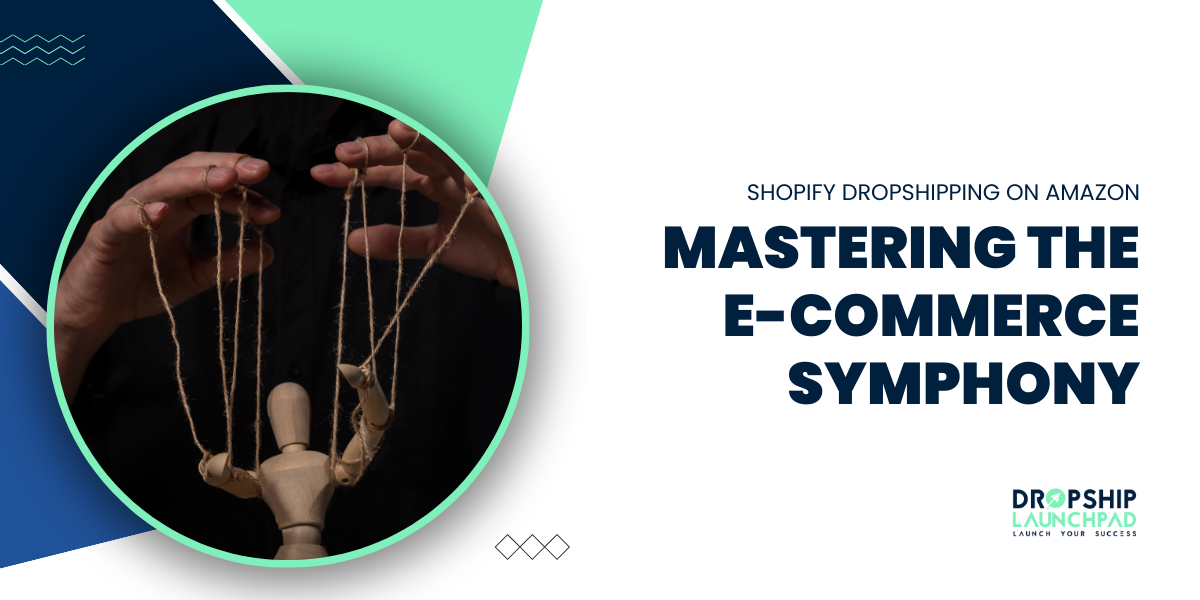Shopify Dropshipping on Amazon – Explore the World of E-commerce with the Perfect Combination
Look around! The world is buzzing with online businesses, and it’s not hard to see why. E-commerce has exploded in popularity due to the ease of online purchasing and the growing power of product endorsements by social media stars. And when it comes to dominating the e-commerce game, two names stand out: Shopify and Amazon.
But what if we told you that you don’t have to choose between these two giants? Yes, you heard it right! You can combine the power of Shopify and Amazon through dropshipping. In this article, we will delve into the world of Shopify dropshipping on Amazon and master the e-commerce symphony.
What is Amazon?

Amazon needs no introduction. Founded in 1994 by Jeff Bezos, this tech giant has evolved from an online bookstore to the world’s largest e-commerce marketplace. With over 350 million products available, Amazon caters to a vast audience and offers a seamless shopping experience.
But what sets Amazon apart is its Fulfillment by Amazon (FBA) service, which lets vendors keep their inventory in Amazon’s warehouses and take advantage of Amazon’s speedy shipping infrastructure. This has helped local merchants attract a wider audience and compete with national chains.
How does Amazon Work?

Amazon is based on a straightforward premise: customers go to the website, peruse the available goods, and make a purchase. But behind the scenes, a complex web of algorithms and processes keeps the platform running smoothly. Let’s take a closer look at how Amazon works.
Product Listing
You need to list your products on the platform to sell on Amazon. This involves providing a product title, description, images, and other relevant details. It is crucial to optimize these listings with keywords and high-quality images to increase visibility and attract potential customers.
Inventory Management
Another important aspect of selling on Amazon is managing inventory levels. You need to ensure that you have enough stock to fulfill orders but not too much that it becomes a burden on your finances. When using FBA, inventory management is simplified because Amazon handles product storage and distribution.
Customer Service
Amazon prides itself on its exceptional customer service. From handling returns and refunds to addressing customer queries, Amazon ensures a positive customer shopping experience. As a seller, you must maintain good customer service to build trust and encourage repeat purchases.
How does Shopify dropshipping work with Amazon?

Now, let’s talk about the star of this article – dropshipping. In simple terms, dropshipping is a retail fulfillment method in which the seller does not hold inventory but transfers customer orders directly to the manufacturer or supplier. This means the seller only purchases the product from the manufacturer once a customer orders.
So, how does Shopify dropshipping work with Amazon? Well, it’s pretty straightforward. You can use Shopify as your online store and connect it to Amazon through various apps and integrations on the platform. This allows you to list products on Amazon without actually holding the inventory. When a customer orders, it is automatically sent to the supplier, who then fulfills and ships the product directly to the customer.
Amazon Dropshipping vs Amazon FBA: Which is Better?
When selling on Amazon, you have two options – Amazon dropshipping and using Amazon FBA. Both have their advantages and disadvantages, but which one is better? The answer depends on your business goals and personal preferences.
- Dropshipping may be the way to go if you have a unique and unavailable product on Amazon.
- FBA may be a better option to reach a wider customer base and have a larger inventory to manage. It also offers the convenience of hands-off fulfillment, allowing you to focus on other aspects of your business.
Shopify Dropshipping on Amazon: Pros and Cons

As with any business model, dropshipping on Amazon has pros and cons. Let’s take a look at the advantages and disadvantages of this approach.
Pros
- Low startup costs: Since you don’t need to invest in inventory, the initial cost of starting a dropshipping business on Amazon is significantly lower than traditional retail models.
- Wide reach: With over 200 million monthly visitors, Amazon offers a massive customer base, making it easier for your products to get noticed.
- Reduced risk: With dropshipping, you don’t have to worry about stocking up on inventory that may not sell. This reduces the risk of losses and allows for more flexibility in your product offerings.
- FBA benefits: You can use Amazon’s FBA service to take advantage of their efficient shipping process and customer service, giving your business a professional edge.
Cons
- High competition: With the low barrier to entry, there is high competition on Amazon. You need a solid marketing strategy and unique products to stand out.
- Limited control: Since you don’t hold inventory, you have limited control over the quality of products and shipping times. This could lead to negative customer experiences and impact your business’s reputation.
- Fees: Amazon charges various fees for selling on their platform, including referral and FBA fees. Eventually, these expenditures will eat away at your profits.
What is the difference between Shopify, Amazon Dropshipping, and Amazon FBA?

Although Shopify dropshipping and Amazon FBA involve selling products without holding inventory, they have significant differences.
Shopify Dropshipping
- Requires a separate platform: Shopify is a standalone e-commerce platform that you must use to run your online store.
- More control over products: As a dropshipper, you have more control over the products you sell, including pricing and branding.
- Higher profit margins: Since you don’t have to pay for inventory upfront, your profit margins can be higher than traditional retail models.
- No storage or shipping responsibility: With dropshipping, the supplier manages storing and shipping products, reducing your workload.
Amazon FBA
- Uses Amazon as a platform: With FBA, you sell directly on Amazon’s marketplace, utilizing their massive customer base.
- Limited control over products: As a third-party seller on Amazon, you have limited control over branding and pricing.
- Lower profit margins: With fees for selling on Amazon and utilizing FBA services, your profit margins may be lower than Shopify dropshipping.
- Increased competition: As a seller on Amazon, you are competing with millions of other sellers, making it challenging to stand out. However, utilizing FBA can give you a competitive advantage.
Amazon Dropshipping
- Products sourced from third-party suppliers: With Amazon dropshipping, you are sourcing products from other retailers or wholesalers and reselling them on Amazon.
- May violate Amazon’s policies: Dropshipping is not explicitly prohibited by Amazon but goes against their guidelines of providing a positive customer experience.
- Limited control over inventory: You risk being unable to fulfill orders if your supplier runs out of stock and you do not keep inventory.
- Higher risk of negative reviews: If your supplier provides poor-quality products or slow shipping times, it can lead to negative reviews and impact your seller rating on Amazon. However, if done correctly with reputable suppliers, Amazon dropshipping can be profitable.
Every approach has pros and cons, and you need to weigh them carefully to find the one that works best for your company. Shopify dropshipping and Amazon FBA offer unique advantages to help you reach your business goals. Ultimately, it’s about finding the right balance between control, profit margins, and risk for your business needs.
Is Amazon Dropshipping Profitable?

The answer to this question is more complex than yes or no. As with any business model, the profitability of Amazon dropshipping depends on various factors, such as your niche, product selection, and marketing strategies.
Factors that can affect the profitability of Amazon dropshipping
- Niche selection: Choosing a profitable niche is crucial for success in dropshipping. You want to avoid oversaturated markets and look for trending or niche products with higher demand.
- Supplier selection: Working with reliable and reputable suppliers is essential for maintaining good quality products, timely shipping, and avoiding negative reviews.
- Marketing strategies: You will need an excellent advertising strategy to succeed on Amazon. This may include optimizing your product listings, utilizing sponsored ads, and building a strong social media presence.
- Amazon fees: As mentioned earlier, Amazon charges various fees for selling on their platform. These expenses could affect your profit if you do not factor them in.
- Customer service: Provide first-rate support to your Amazon customers, as you would with any other business. Negative reviews and ratings can harm your sales and profitability.
The popularity of Amazon
Since its founding, Amazon has focused on providing its customers with the best possible shopping experience, which has earned it a place among the most visited websites worldwide. In 2022, Amazon was ranked as the most trusted brand by US consumers, cementing its position as a leader in the e-commerce industry.
With its vast reach and efficient shipping services, Amazon ships to customers in more than 100 countries and regions, providing a convenient shopping experience for millions worldwide. Customers complete almost one-third of their Amazon purchases in 3 minutes or less and half in under 15 minutes.
One of the key factors contributing to Amazon’s popularity is its partnership with independent sellers. These small and medium-sized businesses contribute to over 60% of sales in Amazon stores and have helped improve product selection, prices, and overall customer experience. Furthermore, US-based sellers on Amazon had an average sales figure of more than $230,000 in 2022, showcasing the potential for growth and success for independent sellers on the platform.
Amazon’s popularity also extends to its brand owners, with sales growing by more than 20% in the Amazon store 2022. The company has invested over $1.2 billion and employed thousands of experts to protect customers, brands, sellers, and vendors from counterfeits and other forms of abuse. Amazon is dedicated to providing a reliable marketplace for all its customers, so the company uses a program called Brand Registry to remove or block nearly all counterfeit product listings proactively.
How Much Does it Cost to Dropship on Amazon?
The cost of dropshipping on Amazon can vary depending on the product type and other factors. However, some common fees that sellers may encounter include:
- Referral fees: To use the Amazon marketplace, sellers must pay a referral fee to Amazon ranging from eight percent to fifteen percent of the sale price.
- Shipping fees: As an FBA seller, you will also be responsible for shipping fees to Amazon’s fulfillment centers, which can vary based on the weight and size of your products.
- FBA fees: Amazon also charges additional fees for using their fulfillment services, including storage fees, pick and pack fees, and order handling fees.
- Other potential expenses: As with any business, there may be other costs involved in running your Amazon dropshipping business, such as marketing expenses, software or tools, and customer service costs.
It’s important to consider these fees and expenses carefully when deciding whether Amazon dropshipping is profitable for your business. Conduct thorough research and analyze your potential profit margins to ensure the numbers make sense before starting.
How to Start Shopify Dropshipping on Amazon?

So far, we’ve discussed the basics of Amazon dropshipping, its pros and cons, and factors that can affect profitability. Let us jump into a detailed walkthrough of Shopify’s Amazon dropshipping features.
Step 1: Create an Amazon Seller Account
Those who wish to sell goods on Amazon must first register as sellers. Accounts are divided into two categories: personal and business. The individual account has no monthly fee but charges a $0.99 fee per item sold, while the professional account costs $39.99 per month and does not charge per-item fees.
Step 2: Set up Shopify Store
Next, you must create a Shopify store and set it up according to your brand and product niche. This includes designing your store, adding products, and setting up payment and shipping options.
Step 3: Integrate Shopify with Amazon
Shopify’s Amazon integration makes moving your products to the marketplace easy. This will save you time in manually listing each product on Amazon.
Step 4: Optimize Your Product Listings
Optimizing your product listings on Amazon with eye-catching images, thorough descriptions, and pertinent keywords will boost your products’ discoverability and sales.
Step 5: Utilize Sponsored Ads
Amazon offers various advertising options for sellers to promote their products. Consider utilizing sponsored ads to increase your products’ visibility and increase sales.
Step 6: Fulfill Orders with FBA
To take advantage of Amazon’s efficient shipping services, you can enroll in their FBA program. By doing so, orders for your products will be processed and shipped from Amazon’s fulfillment centers.
Step 7: Monitor Performance and Make Adjustments
As with any business, monitoring your performance and making necessary adjustments is crucial for success. If you want to succeed at dropshipping, you must keep track of sales, customer comments, and costs.
How to Win the Shopify Dropshipping Game with Amazon: Pro Tips
Congratulations! You now have a Shopify store set up and integrated with Amazon. Here are some pro tips to help you win the dropshipping game on Amazon:
Lay Your Hands On Amazon’s Best Selling Niche:
One way to stand out on Amazon is to sell products in the best-selling niches. You can conduct research and use tools like Jungle Scout to identify profitable niches with high demand. However, some of all time favorite niches of Amazon include:
- Beauty & Personal Care.
- Books
- Camera & Photo.
- Clothing, Shoes & Jewelry.
- Electronics.
- Home & Kitchen.
- Patio, Lawn & Garden.
- Pet Supplies.
Offer Competitive Pricing:
Pricing can make or break your sales in a competitive marketplace like Amazon. Research your competitors’ prices and adjust yours to offer a competitive product price. You could also follow Amazon’s lead and implement a dynamic pricing strategy to respond fully to demand and competition.
Focus on Product Quality and Reviews:
Product quality plays a significant role in customer satisfaction and reviews, which, in turn, can affect your sales. Ensure your products are of high quality and promptly address customer complaints or issues to maintain positive reviews.
Utilize Amazon’s Marketing Tools:
Amazon offers various marketing tools for sellers, such as sponsored ads, coupons, and promotions. Take advantage of these tools to increase your product visibility and attract more customers. More people can be reached through social media and influencer marketing.
Stay Up-to-Date with Amazon Policies:
Amazon’s policies and guidelines constantly evolve, so staying current is essential to avoid potential issues or penalties. Regularly check for updates and make changes to your dropshipping strategy accordingly.
FAQs about Shopify Dropshipping on Amazon

Can you use Amazon with Shopify dropshipping?
Yes, Amazon and Shopify can be integrated to allow for dropshipping on Amazon using the products listed on your Shopify store.
Is Amazon dropshipping profitable?
Profitability in Amazon dropshipping is contingent on several variables like product mix, market saturation, pricing strategy, and overhead costs. Thorough research and careful planning are necessary to ensure profitability. ̴
Is Amazon OK with dropshipping?
Yes, Amazon allows dropshipping if the seller follows their policies and guidelines. This includes providing accurate product information, processing orders on time, and maintaining good customer service. Failure to comply with these guidelines may result in penalties or suspension of selling privileges. It is essential to stay updated on Amazon’s policies to avoid any issues with dropshipping. ̴
Can I sell items on Shopify from Amazon?
Using the integrated functionality between Shopify and Amazon, you can sell products from Amazon on your online store. This allows for a more efficient and streamlined process of listing products on both platforms. However, it’s important to note that you must comply with Amazon’s policies and guidelines when dropshipping their products. ̴
What is the difference between Shopify dropshipping and Amazon dropshipping?
The main difference between Shopify dropshipping and Amazon dropshipping is the platform used for selling. With Shopify, you have more control over your store’s branding and customer experience, while Amazon provides a larger customer base and advanced fulfillment services through its FBA program. It’s also important to note that you are responsible for sourcing products from suppliers with Shopify dropshipping, whereas, with Amazon dropshipping, you are selling products already listed on the platform. ̴
Is Shopify better than Amazon for dropshipping?
Ultimately, the answer to this question depends on your personal preferences and business needs. Some may succeed with Shopify, while others prefer Amazon’s wider reach and fulfillment services. Doing your homework and considering your options before settling on a dropshipping platform is important.
Get Started With Your Shopify Dropshipping on Amazon With a Prebuilt Shopify Store at Dropship Launchpad:
At Dropship Launchpad, we offer prebuilt Shopify stores with hand-picked niches and proven successful products on Amazon. Our team of experts also provides support and guidance to help you get started with dropshipping on Amazon successfully. For more information on how we can assist you in your dropshipping efforts on Amazon, please visit dropshiplaunchpad.com. ̴́
Conclusion: Shopify Dropshipping On Amazon
In conclusion, Shopify dropshipping on Amazon can be profitable if done correctly. Increasing your chances of success on Amazon requires careful consideration of the fees and expenses involved and the steps and pro tips mentioned in this guide. Remember to continuously monitor your performance and adapt to stay ahead in the competitive market. Happy dropshipping! ̴́

 Shopify Dropshipping: 2024’s Ultimate Key Insights
Shopify Dropshipping: 2024’s Ultimate Key Insights  What is Shopify Dropshipping: E-Commerce Solution in 2024
What is Shopify Dropshipping: E-Commerce Solution in 2024  How to Dropship on Shopify: 2024 Ultimate Success Playbook
How to Dropship on Shopify: 2024 Ultimate Success Playbook  Top Shopify Dropshipping Suppliers: 12 Best Partners in 2024
Top Shopify Dropshipping Suppliers: 12 Best Partners in 2024